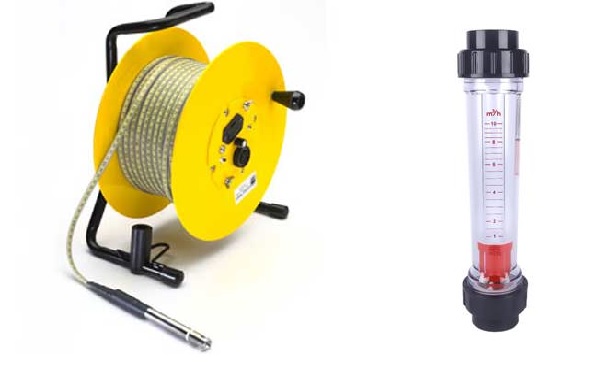MODULE, PUMPING TEST, for electrical submersible pump
Valid Article
MODULE, PUMPING TEST, for electrical submersible pump
Definition
A pumping test is used to estimate the hydraulic properties of aquifers, evaluate well performance, and to identify aquifer boundaries, suitable submersible pumps and the correct pump setting.
Indications
Pumping tests must be carried out after a new borehole is drilled or when a borehole with unknown hydraulic properties is used or rehabilitated.
Carefully measuring, controlling and recording the flow rate throughout the test is essential for a successful outcome.
Common types of pumping tests are:
- Constant-rate tests maintain pumping at a constant rate. This is the most commonly used pumping test method for obtaining estimates of aquifer properties.
- Step-drawdown tests proceed through a sequence of constant-rate steps to determine well performance characteristics such as well loss and well efficiency.
- Recovery tests use water-level (residual drawdown) measurements after the termination of pumping. Although often interpreted separately, a recovery test is an integral part of any pumping test.
Step drawdown pumping tests are the more commonly used to determine operating flow of borehole/well : see also "Public Health Engineering in Precarious Situations", MSF,2nd edition, 2010: chapter T.B. 2.27 Determination of the maximum pumping rate of a well, for useful guidance.
If you have any doubts on how to carry out the test, or in interpreting the results, please refer to your WHS referent.
Specifications
Components
The kit contains:
- ASSEMBLY ROLLING WHEEL for hose, to assemble
- ASSEMBLY FLOWMETER, 1-10 m³/h, 2 pcs + trunk
- DIPMETER water level, up to 100 metre
Instructions for use
Precautions for Use
The water extracted during the test must be discharged correctly to avoid environmental damages and impact on the pumping test!
- If water is tested and fit for human consumption, discharge into a distribution tank might be an option.
- Avoid direct discharge of water on the ground surface if the water is likely to recharge the pumped aquifer (e.g., a shallow unconfined aquifer or karst aquifer with sinkholes). Recycling of the pumped water through recharge can result in the false identification of a constant-head boundary or leakage.
- Discharge of water to a surface water feature such as a stream is a viable option if it is anticipated that the surface water body is hydraulically disconnected from the pumped aquifer or if it behaves as a constant-head boundary.
- Avoid adverse biological, water-quality, erosion or sediment mobilization impacts when discharging to groundwater or surface water.
Examples of Use
- identify hydraulic properties of aquifers
- identify a suitable pump
- identify maximum yield of borehole - avoid over pumping!
- identify correct pump setting
Storage
- clean thoroughly before storing
- store in clean, dry and locked storage facilities
- remove battery of dipper to avoid damages due to leaking battery


![[CWATASSYE01] ASSEMBLY ROLLING WHEEL for hose, to assemble](/web/image/product.template/550389/image_256/%5BCWATASSYE01%5D%20ASSEMBLY%20ROLLING%20WHEEL%20for%20hose%2C%20to%20assemble?unique=7eb29da)
![[CWATASSYM01] ASSEMBLY FLOWMETER, 1-10 m³/h, 2 pcs + trunk](/web/image/product.template/550777/image_256/%5BCWATASSYM01%5D%20ASSEMBLY%20FLOWMETER%2C%201-10%20m%C2%B3-h%2C%202%20pcs%20%2B%20trunk?unique=7eb29da)
![[CWATMEAED10] DIPMETER water level, up to 100m](/web/image/product.template/545835/image_256/%5BCWATMEAED10%5D%20DIPMETER%20water%20level%2C%20up%20to%20100m?unique=c6f2fd2)
![[KWATKPUES5-] KIT, PUMP, ELECTRICAL, SUBMERSIBLE (Grundfos SQ 5-70) +cable](/web/image/product.template/551006/image_256/%5BKWATKPUES5-%5D%20KIT%2C%20PUMP%2C%20ELECTRICAL%2C%20SUBMERSIBLE%20%28Grundfos%20SQ%205-70%29%20%2Bcable?unique=446b334)